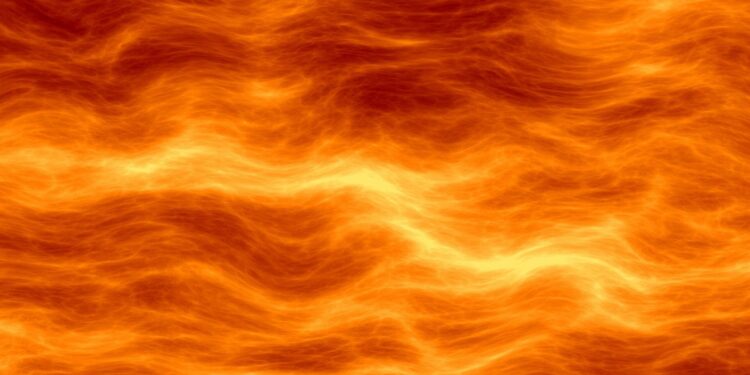Credit: Pixabay/CC0 Public domain
For about 20 years, Paul Bellan, a professor of applied physics at Caltech, and his group have been creating magnetically accelerated jets of plasma, an electrically conductive gas composed of ions and electrons, in a vacuum chamber large enough to hold a person . (Neon signs and lightning bolts are everyday examples of plasma).
In this vacuum chamber, volutes of gas are ionized by several thousand volts. Then 100,000 amps pass through the plasma, producing powerful magnetic fields that turn the plasma into a jet traveling at about 10 miles per second. High-speed recordings show the jet going through several distinct stages within tens of microseconds.
Bellan says the plasma jet looks like an umbrella extending. Once the length reaches a foot or two, the jet experiences instability that turns it into a rapidly expanding corkscrew. This rapid expansion triggers a different, faster instability that creates ripples.
“The ripples choke the jet’s 100-kiloampere electrical current, much like placing your thumb on a water pipe restricts the flow and creates a pressure gradient that accelerates the water,” says Bellan. “Quenching the jet current creates an electric field strong enough to accelerate electrons to high energy.”
These high-energy electrons had already been identified in the jet experiment thanks to the X-rays they generate, and Bellan says their presence was a surprise. Indeed, conventional understanding says that the plasma jet was too cold for the electrons to be accelerated to high energy. Note that “cold” is a relative term: although this plasma has a temperature of around 20,000 Kelvin (35,500°F) – far hotter than anything humans normally encounter – it is far from cold. close to the temperature of the solar corona, which is greater than 1 million Kelvin (1.8 million degrees F).
“The question is: ‘Why do we see X-rays?’ “, he said.
Cold plasmas were thought to be incapable of generating high-energy electrons because they are too “collisional,” meaning that an electron cannot travel very far before colliding with another particle. It’s like a driver trying to speed race in highway traffic. The driver could step on the accelerator but would only travel a few meters before crashing into another car. In the case of a cold plasma, an electron would only accelerate about a micron before colliding and slowing down.
The Bellan group’s first attempt to explain this phenomenon was a model suggesting that a fraction of electrons manage to avoid colliding with other particles during the first micron of travel. According to the theory, this allowed the electrons to accelerate at a slightly higher speed, and once faster, they could travel a little further before encountering another particle with which they could collide.
A fraction of these now faster electrons would avoid collision again for a while, allowing them to reach an even higher speed, which would allow them to travel even further, creating a positive feedback loop that would allow a few lucky electrons to go further. and faster, reaching high speeds and energies.
But although convincing, the theory was wrong, Bellan says.
“We realized that this argument had a flaw,” he says, “because electrons don’t really collide in the sense of hitting something or not hitting something. They are actually all deflected a little bit all the time. So there is no fault. a thing like an electron colliding or not colliding.
Yet high-energy electrons appear in the cold plasma of the jet experiment. To find out why, Bellan developed computer code that calculated the actions of 5,000 electrons and 5,000 ions continually deflecting from each other in an electric field. To understand how a few electrons managed to reach high energies, he tweaked the parameters and observed how the behavior of the electrons changed.
As electrons accelerate in the electric field, they pass close to the ions but never touch them. Sometimes an electron passes so close to an ion that it transfers energy to an electron attached to the ion and slows down, with the ion now “excited” radiating visible light. Because electrons only occasionally pass so close, they usually move slightly away from the ion without exciting it. This occasional energy leak occurs in most electrons, meaning they never reach high energies.
When Bellan refined his simulation, a few high-energy electrons capable of creating X-rays appeared. “The lucky few who never get close enough to an ion to excite it never lose energy,” he adds. “These electrons are continually accelerated in the electric field and eventually reach sufficient energy to produce X-rays.”
Bellan says that if this behavior occurs in the plasma jet in his Caltech lab, it probably also occurs in solar flares and astrophysical situations. This may also explain why unexpectedly high-energy X-rays are sometimes observed in fusion energy experiments.
“There’s a long history of people seeing things that they thought were a useful fusion,” he says. “It turned out to be fusion, but it wasn’t really useful. It was intense transient electric fields produced by instabilities accelerating a few particles to extremely high energy. This could explain this was happening. It’s not what people want, but it’s probably what’s happening.
The paper describing the work, “Production of energetic electron tails from binary encounters of discrete electrons and ions in a sub-Dreicer electric field,” was published in the October 20 issue of Plasma Physics and was presented November 3 at the 65th Annual Meeting of the Division of Plasma Physics of the American Physical Society in Denver, Colorado.
More information:
Paul M. Bellan, Energy production of electron tails from binary encounters of discrete electrons and ions in a sub-Dreicer electric field, Plasma Physics (2023). DOI: 10.1063/5.0167004
Provided by California Institute of Technology
Quote: Physicist explains X-rays that should not exist in ‘cold’ plasma (December 5, 2023) retrieved December 5, 2023 from
This document is subject to copyright. Apart from fair use for private study or research purposes, no part may be reproduced without written permission. The content is provided for information only.



